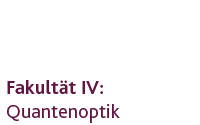MAGIC
Quantum dynamics of trapped ions in a dynamic field gradient using dressed states
References: [QIS50]
Novel ion traps that provide either a static or a dynamic magnetic gradient field allow for the use of radio frequency (rf) radiation for coupling internal and motional states of ions, which is essential for conditional quantum logic. We show that the coupling mechanism in the presence of a dynamic gradient is the same, in a dressed state basis, as in the case of a static gradient. Then, it is shown how demanding experimental requirements arising when using a dynamic gradient could be overcome. Thus, using dressed states in a dynamic gradient field could decisively reduce experimental complexity on the route towards a scalable device for quantum information science based on rf-driven trapped ions.
Simplified implementation of the quantum Fourier transform with Ising-type Hamiltonians: Example with ion traps
References: [QIS45]
We propose a simplified mathematical construction of the quantum Fourier transform which is suited for systems described by Ising-type Hamiltonians.
By contrast to the standard Cooley-Tuckey scheme, which prescribes sequences of CPHASE gates, our implementation is based on one-qubit gates and a free evolution process.
We also show how to obtain a quadratic speed-up by applying the conditional interactions simultaneously.
Thus rather than O(N2)our implementation time scales as O(N).
Finally, we show a realization of our method with homogene
ous microwave driven ion traps in a magnetic field with gradient.
Magnetic Gradient Induced Coupling (MAGIC)
References [QIS14, QIS13, QIS10, QIS8, QIS3]
Nuclear magnetic resonance applied to macroscopic ensembles of molecules and electrodynamically trapped ions, are two out of (meanwhile) numerous physical systems that have been successfully used to demonstrate quantum logic operations, and even complete quantum algorithms. Also, their specific advantages and shortcomings have been the subject of detailed studies. By combining and developing the best features of two experimental "worlds" - nuclear/electron spin resonance and trapped ions - this work targets a promising approach to quantum computing and quantum simulation where a string of ions is used as a designed N-qubit "molecule".
It has been shown (References: [QIS14], [QIS13], [QIS10], [QIS8], [QIS3]), that the addition of a magnetic field gradient to a linear ion trap i) makes the ions serving as qubits distinguishable in frequency space such that they can be individually addressed, and ii) induces pair wise spin-spin coupling between individual qubits.
The collection of trapped ions can thus be viewed as an N-qubit molecule with adjustable coupling constants [QIS8]. This coupling can be formally described in the same way as J-coupling in molecules used for NMR, even though the physical origin of the interaction is very different. Thus, successful techniques and technology developed in spin resonance experiments, like NMR or ESR, can immediately be applied to trapped ions. In a "real" molecule different nuclear spins share binding electrons that generate a magnetic field at the location of the nuclei, and the energy of a nuclear spin exposed to the electrons' magnetic field depends on the charge distribution of the binding electrons. If a particular nuclear spin is flipped, the interaction with the surrounding electrons will slightly change the electrons' charge distribution which in turn may affect the energy of other nuclear spins. This indirect spin-spin coupling is realized in this new type of ion trap in a different way: the role of the electrons' magnetic field is replaced by the vibrational motion of the ions.

Figure 1:
Left: 7-qubit molecule used for NMR quantum
computing (from Vandersypen et al., Nature 414, 883, 2001).
Nuclear spins are used as qubits (symbolised by vertical
arrows). Electrons mediate the coupling between nuclear spins.
The constant Jij gives a measure for the coupling strength
between spin i and spin j.
Right: Illustration
of a single "designer" molecule in a linear ion trap. The
harmonic trapping potential together with Coulomb repulsion
couple the ions' motional degrees of freedom (symbolised by
springs.) A magnetic field gradient (symbolized by the arrow
labelled B) causes a position dependent shift of qubit
resonances (hyperfine states) such that the qubits can be
addressed individually. In addition, this gradient leads to
pairwise coupling of internal qubit states of different ions
allowing for conditional quantum dynamics. The spin-spin
coupling constants Jij are adjustable through variation of the
static field gradient and the trapping potential. Efficient
read out of individual qubits is achieved by scattering of
resonance fluorescence.
Designing spin-spin interactions
References [QIS31]
We discuss the experimental feasibility of quantum simulation with trapped ion crystals, using magnetic field gradients. We describe a micro structured planar ion trap, which contains a central wire loop generating a strong magnetic gradient of about 20 T/m in an ion crystal held about 160 μm above the surface.
On the theoretical side, we extend a proposal about spin-spin interactions via magnetic gradient induced coupling (MAGIC) [QIS25]. We describe aspects where planar ion traps promise novel physics: spin-spin coupling strengths of transversal eigenmodes exhibit significant advantages over the coupling schemes in longitudinal direction that have been previously investigated. With a chip device and a magnetic field coil with small inductance, a resonant enhancement of magnetic spin forces through the application of alternating magnetic field gradients is proposed. Such resonantly enhanced spin-spin coupling may be used, for instance, to create Schrödinger cat states.
Finally we investigate magnetic gradient interactions in two-dimensional ion crystals, and discuss frustration effects in such two-dimensional arrangements.
